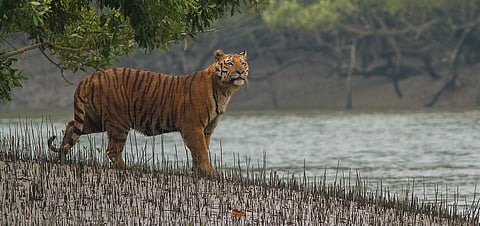

The Sundarbans National Park has experienced a deterioration in its conservation outlook status from ‘Good with Some Concerns’ to ‘Significant Concerns’ in five years. The status changed from 2020 to 2025, the International Union for Conservation of Nature (IUCN) revealed in its report IUCN World Heritage Outlook 4 — A conservation assessment of all Natural World Heritage Sites released at the ongoing IUCN Congress in Abu Dhabi.
According to the report, the park is threatened by salinity, heavy metal contamination and unsustainable resource extraction. Climate change impacts such as sea level rise and more frequent storm surges are negatively impacting mangroves by reducing their diversity, it pointed out.
Additionally, mangrove systems located in the Bangladesh portion of the Sundarbans are facing a pathogenic threat in the form of ‘top dying’ disease.
Hunting, which was the greatest threat to Natural World Heritage Sites in Asia five years back, has now been replaced by climate change, according to the report. It is followed by tourism, infestation of alien species, roads and railroads.
Anthropogenic threats such as high demand for land has resulted in rapid habitat clearance and land use changes. Forest fires, hunting, roadkill, waste disposal, encroachment, illegal logging, road construction and other development activities are causing habitat alteration and biodiversity loss even within legally protected areas, the authors said.
The analysis stated that besides anthropogenic pressures, climate change has accelerated biodiversity loss in Asia by altering ecosystems, causing corals to bleach and Himalayan glaciers to melt, thus directly threatening access to freshwater ecosystems.
Besides the Sundarbans, the Manas National Park and Western Ghats in India continue to remain in the ‘Significant Concern’ category.
The Great Himalayan National Park Conservation Area, Kaziranga National Park, Keoladeo National Park, Nanda Devi and Valley of Flowers National Parks have been classified as ‘Good with Some Concerns’.
Only the Khangchendzonga National Park remained ‘Good’ in Conservation Outlook Rating.
Approximately half (49 per cent) of the UNESCO Natural World Heritage Sites in Asia were assessed as having management effectiveness of ‘some concern’ (or ‘serious concern’ at two per cent).
Globally, the latest IUCN World Heritage Outlook assessment portrays a grim picture for all Natural World Heritage Sites, with regional conservation outlook trends revealing an overall worsening situation for these irreplaceable natural areas.
“The percentage of sites with a positive conservation outlook has, for the first time, decreased significantly. Of the 228 sites assessed since 2014, 63 per cent of sites had a positive outlook in 2014, 2017 and 2020; however, the IUCN World Heritage Outlook 4 shows that in 2025 only 57 per cent of these sites have a positive conservation outlook,” the report said.
Climate change remains the top threat globally to all the 228 Natural World Heritage Sites in the list, with 43 per cent (117) of the sites having climate change as ‘High’ or a ‘Very High’ threat. It is also the fastest growing current threat.
Since 2014, when the first assessment was made, 31 sites — 14 per cent of the total — show an increase in the threat by climate change as ‘High’ to ‘Very High’ between 2020 and 2025.
Climate change is followed by invasive species as a threat, especially on islands: Galápagos Islands (Ecuador), Lord Howe Island Group (Australia), Vallée de Mai Nature Reserve (the Seychelles), Cocos Island National Park (Costa Rica), New Zealand Sub-Antarctic Islands (New Zealand) and Socotra Archipelago (Yemen).
Invasive alien species now affect 30 per cent of all sites.
“In the Galápagos Islands (Ecuador), invasive alien species are considered one of the main causes of extinctions. So far, 1,575 species (terrestrial and marine) have been introduced and established in the archipelago. Most are not problematic, such as agricultural and ornamental plants. However, 59 introduced species are highly invasive and 83 are potentially invasive, negatively affecting the flora and fauna of the islands,” the report said.
It added that climate-related changes will most certainty further increase the distribution of invasive alien species, with their populations expected to respond to varying changes in temperature, moisture and biotic interactions.
The report identified pathogens —wildlife and plant diseases — as the second fastest growing threat in 2025. In 2020, only two sites reported a ‘High’ or ‘Very High’ threat from pathogens. This increased to 19 sites in 2025, the IUCN report said.
“Predicting how invasive alien species and pathogens will respond under potential climate change scenarios is difficult but essential to developing effective prevention, control, and restoration strategies,” the authors said.
The report underlined the growing need for the ‘One Health’ approach encompassing people, species and ecosystems with understanding the links to human health with respect to these sites.